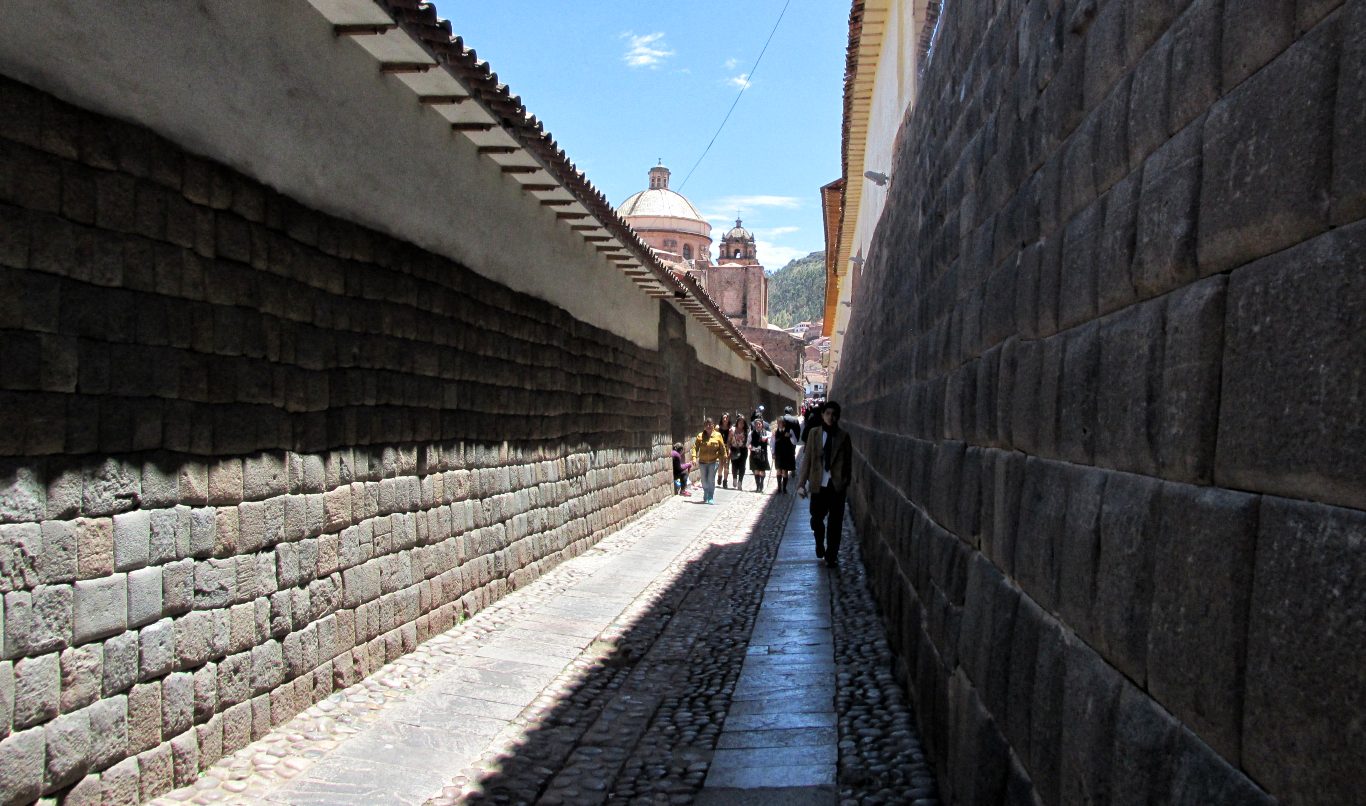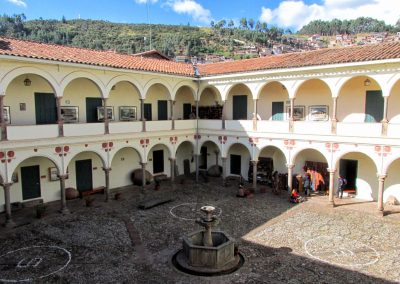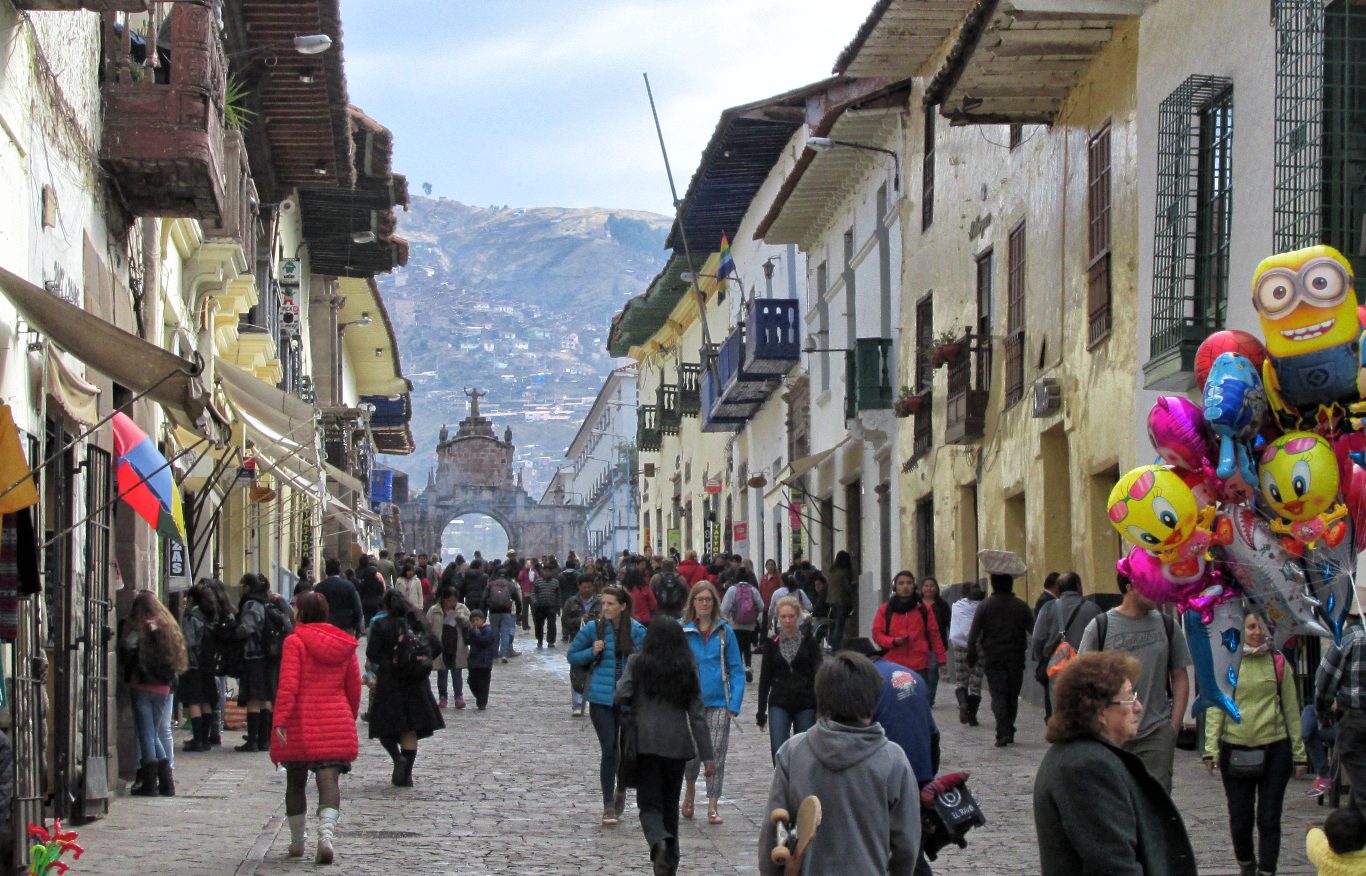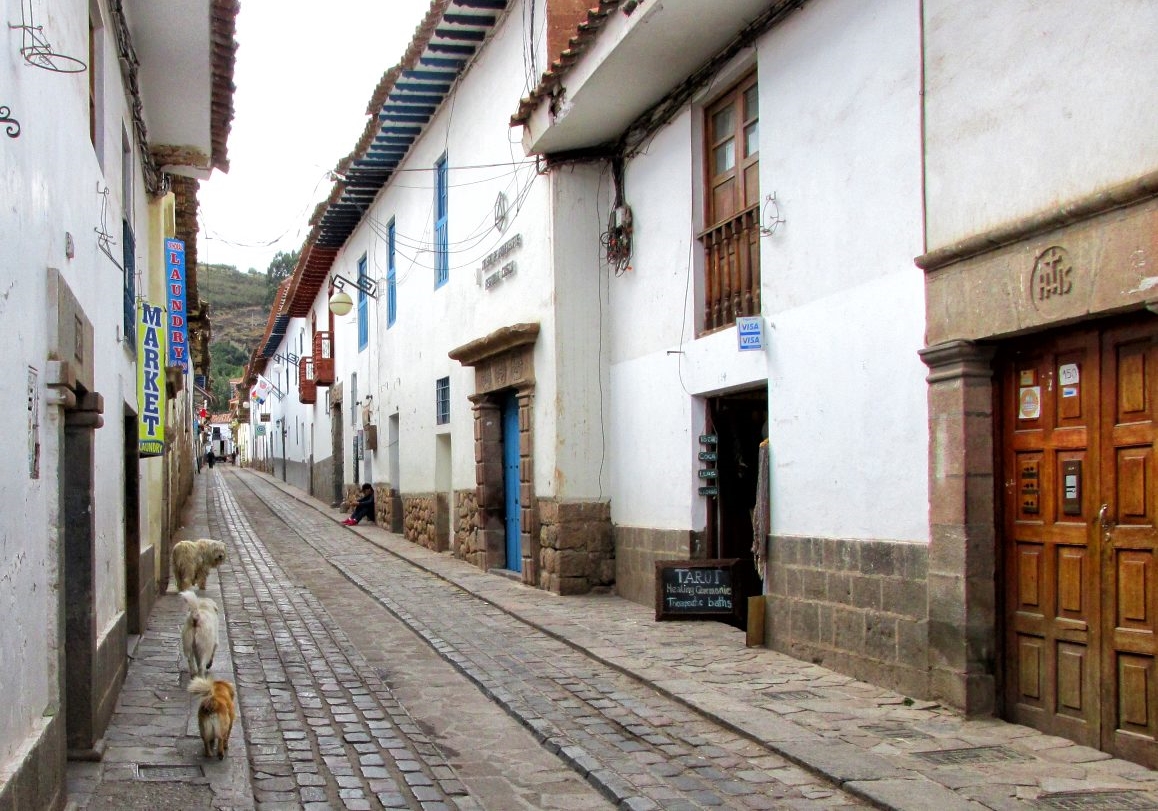To call Cusco a city of contrasts would be a huge understatement. Beautifully preserved, restored and renovated, the entire historic downtown area is a UNESCO World Heritage site, whose streets and walls, roofs and gardens, ditches and drains reveal the work of pre-Incas, Incas, and Spanish colonial power.
It’s an enchanting city, from the narrow streets of the San Blas district down to the regal Plaza de Armas with its cathedrals and colorful processions. Traditional markets sell everything from touristy trinkets to fresh chickens to bags of coca leaves. Old women in traditional Andean dress wander the streets leading llamas and alpacas, posing for tourists, a picture worth a thousand words and at least a couple of soles.
Tourists pour in and pour out, leave early and return weary from Machu Picchu, the Sacred Valley, and myriad sights and activities in the wider Cusco Region. They eat well in the city; they can sleep well, too, unless they choose a party hostel where lively nights take precedence over rest and recuperation.
Cusco is what you make of it. For many tourists, it’s a picturesque two-day stop-off before and after Machu Picchu. But if you have the luxury of time, it’s a fascinating window into Andean culture, Inca history and the pushes and pulls of a city built by legends and sustained by tourism. And it’s a place that has enough to keep you occupied for, at the very least, a couple of weeks.
Due to the huge amount of sights and attractions in Cusco, around Cusco, and reachable as daytrips from Cusco, this Cusco travel guide will focus only on the city itself. Places reachable from Cusco, including towns and attractions in the Sacred Valley, will be covered in separate articles.
All photos by Tony Dunnell.
Things to Do in Cusco
It’s hard to know where to start with all the things to see and do in Cusco, so I’ll just lay down a list of the most interesting attractions within the city boundaries (well, as far out as Saksaywaman and Qenqo).
- Plaza de Armas (Plaza Mayor de Cusco) — Cusco’s main square is a fine place to hang out, take photos and watch colorful parades. Notable buildings surrounding the square are Cusco Cathedral and the Iglesia de la Compañía de Jesús, both dating back to the 1600s.
- Qurikancha (Coricancha) — This structure was one of the most important temples in the Inca Empire, its walls covered in gold. The gold was stripped to pay the ransom of Atahualpa, and then the Spanish built the Church of Santo Domingo on top of the site. It’s a spectacular place and well worth a visit.
- Saksaywaman (various other spellings) — This huge archaeologically complex sits above Cusco, providing spectacular views of the city. The Inca stonework here is arguably more impressive than at Machu Picchu, with vast blocks joined together with incredible precision. This site is included on the Cusco Tourist Ticket.
- Qenqo — Located just north of Cusco and easy to reach, this megalithic temple was probably used for ritual offerings, perhaps even sacrifices. Also included on the Cusco Tourist Ticket.
- Museo Inka — Possibly the best museum in Cusco. Small, but good for getting a better idea of the Inca civilization.
- Museo Histórico Regional — Another small museum, but better than most in Cusco, with a wide chronological span. And it’s included on the full Cusco Tourist Ticket.
- Monumento a Pachacuteq (Pachacuteq Statue) — Located on a roundabout about 1.25 miles southeast of the Plaza de Armas, this towering statue of the Inca ruler Pachacuteq is quite an impressive sight. You’ll find some displays and info inside the building that forms the base of the statue, but the real highlight is looking across Cusco from the oversized feet of Pachacuteq. Entrance included on full Cusco Tourist Ticket.
- Planetarium Cusco (www.planetariumcusco.com) — I haven’t been to Cusco’s planetarium yet, but I’ve heard good things about it. It’s also a good option if you’re looking for something to do in Cusco at night.
- San Pedro Market — A traditional market located just six blocks southwest of the Plaza de Armas. If you’ve never been to a Peruvian market, this is a good place to start.
- El Baratillo — This sprawling flea market is an absolute treasure trove of total randomness — and I love it. Held every Saturday from 5 a.m. onwards, the market spreads out across numerous streets in an area about four blocks directly south of San Pedro Market. It’s not touristy in any way, and people are always warning about pickpockets and snatch theft. I strolled around the stalls for at least a couple of hours, admiring everything from knuckle dusters to ships in bottles, and it seemed pretty safe to me.
- Just explore — Cusco is a great place to just go walking, be it in the picturesque San Blas district or through the impressive streets of the historic center. The obvious hot spots for touristy strolls are the Plaza de Armas and Hatunrumiyoc Street, the latter being home to the famous 12-angled stone (where you’ll encounter an almost constant choke-point due to lingering tourists).
Where to Stay in Cusco
Whether you’re looking for a double room in a restored colonial mansion or the top bunk in a dirt-cheap but safe and sociable hostel, Cusco pretty much has it all.
But first you need to decide where in Cusco you want to stay. There are hostels and hotel a stone’s throw from the Plaza de Armas, right in the action. It might be noisier, but at least you won’t have to walk too far. And Cusco is a high altitude city, where even a shallow uphill ascent can be a lung-bursting experience.
The San Blas district of Cusco, on the other hand, is a solid slog uphill along cobbled streets. For the unaccustomed, it’s a royal pain in the lungs. That said, San Blas is just about the prettiest part of Cusco, its narrow streets full of hip cafes, great restaurants and shops owned by some of the city’s best artisans.
Alternatively, head six or seven blocks west-southwest from the main square, past Plaza San Francisco, and you’ll come to a part of town that’s not quite so pretty, but cheaper and far less clogged with tourists. Here you’ll find plenty of affordable hostels and midrange hotels.
Of course, you can always look for a place well outside the historic center of Cusco. Speaking very generally, however, the quality, comfort and security of hostels and hotels does decline the further you are from the center. There are exceptions, but do some extra research before choosing accommodation in less popular neighborhoods.
In terms of the price of accommodation in Cusco, you can find dorms for S/ 20 per person (about $6) and even small private rooms for as little as S/ 30 to S/ 40 ($9 to $12). If you actually want to sleep, then avoid the party hostels. You can see my recommendations for cheap and quiet hostels in Cusco here.
Beyond the hostels, you’ll find nondescript, minimal-frills hotels with private rooms from S/ 100 to S/ 200 a night ($30 to $60). Stepping up into the more luxurious three- and four-star range, you can still find a pretty and well-appointed matrimonial room for as little as S/ 300 ($90). Try Illa Hotel in San Blas for the colonial experience at affordable prices.
If you’ve got cash to burn, then go for one of Cusco’s very best hotels, such as Inkaterra La Casona or the Belmond Hotel Monasterio. A night in one of these famous colonial mansions will set you back in excess of US$400.
Restaurants in Cusco
Cusco is a great city for food.
If you’ve been on the road for a while and you’re craving food from home, then there’s a chance you’ll find it in Cusco. Head up to San Blas for Indian food at Korma Sutra, Mexican at Tacomania, and ribs in Cuse Smokehouse. Near the center you’ll find tapas at Cicciolina, epic burgers at Papacho’s and a bunch of kebab places scattered around for soaking up late-night beer.
For traditional Andean dishes, you’ll never be short of options. For chicharron de chancho (lumps of fried pork), head to a street called Pampa del Castillo that leads to the Qurikancha, where you’ll find a handful of chicharronerias including the excellent Los Mundialistas. For more local specialties, head to a quinta or picanteria, a traditional Andean-style restaurant. My favorite is the super-local and slightly rough around the edges Quinta Waly; for something a little more sophisticated, try Quinta Eulalia.
For elevated Peruvian cuisine, head to Marcelo Batata and Uchu, both owned by one of Cusco’s top chefs, Erick Paz Gallegos. Both restaurants are world-class without being pretensions.
Rather than pack this Cusco travel guide with details of all these restaurants and more, I’ve written a separate guide to more than 25 of the best restaurants in Cusco.
Nightlife in Cusco
Cusco is a bar crawler’s Peruvian holiday paradise, apart from when it’s freezing cold at night — which just makes you stay in the bar for longer.
Paddy’s Irish Bar and Norton Rat’s Tavern are two of the most famous and most established bars, both located on the Plaza de Armas. Paddy’s is the more charming of the two, but Norton Rat’s is cheaper, more spacious and, from my experience, has a better mix of locals and tourists.
For craft beer (and maybe some cider), go to Cholos Tap Room, Nuevo Mundo Draft Bar or take a short cab ride to Zenith Brewery. For shots of all shapes and sizes — including in a tea pot and lined up on a ski — you can’t beat La Chupiteria Shot Bar. A totally non-touristy place I like to go is Té Macho II, which specializes in jugs of té macho, a traditional mix of black tea, cinnamon, cloves, sugar, lime juice and pisco brandy — perfect for a cold night.
When it comes to nightclubs in Cusco, I’ll humbly let you make your own minds up. Personally, I have a low tolerance for Cusco’s nightclubs, including popular central options like Temple and Mythology. Maybe I’m just getting old, but I’d rather avoid the tacky meat-markets and go find some live local music in a place like Ukukus or Roswell.
Getting to and Around Cusco
Getting to Cusco is a fairly straightforward process for most travelers, especially from Lima or other major cities in the southern half of the country. You can fly direct from Lima in just over an hour, or take the bus (20+ hours). You can also fly from Arequipa direct to Lima.
There are currently no direct flights from the northern half of Peru to Cusco; you’ll have to fly to Lima for an onward flight to Cusco.
Getting around in Cusco is easy, unless you’re puffing and panting your way uphill. The city isn’t all that big — the population is about 430,000, making it the seventh largest city in Peru — so you can get to most places fairly quickly by taxi.
The biggest taxi rip-off in Cusco is at the airport, where official taxis will take you to the historic center for about S/ 40. If you just step outside onto the street, you’ll pay S/ 10 for the same trip. It’s safe enough to this during the day, but you might want to take an official airport taxi at night.
Safety in Cusco
Cusco is a fairly safe city, especially in the historic center. Tourist police roam around the Plaza de Armas and adjoining streets during the day and at night.
Always be more cautious after dark and ideally walk with at least one friend — or take a taxi. Very late at night, even tourist hubs like the San Blas district can be slightly edgy, especially if you find yourself walking in a deserted street. Be very careful at night up near the Saksaywaman archaeological complex, where female tourists have been robbed and raped.
Withdrawing and Exchanging Money in Cusco
You’ll find plenty of ATMs on or near the main square, where you can withdraw soles and dollars (read more about ATMs in Peru here).
If you want to exchange dollars, you can do so inside the banks, at casas de cambio (currency exchange offices/bureaux de change), or with street money changers. The street money changers normally offer the best rates (tipo de cambio). You can read more about money changers and using US dollars in Peru here.
Internet in Cusco
The internet in Cusco is pretty good (read more about internet access in Peru), so you should be able to find somewhere to get online at reasonable speeds. You’ll find internet cafes almost everywhere, but they are becoming more and more obsolete for travelers as almost all hostels and hotels now provide Wi-Fi. Many cafes, restaurants and bars in Cusco also offer free Wi-Fi.
Weather in Cusco
Generally speaking, Cusco has a temperate climate with spring-like days for much of the year. Cusco is driest from May to September, which is also the high season for visitors to Machu Picchu (particularly June, July and August). This period also has the coldest nights, which can be chilly indeed, so pack some warm clothing.
Night temperatures are milder from November to March, but this is also the wettest period. January and February can be particularly wet.
Festivals and Events in Cusco
- Carnival — throughout February: Takes place throughout the streets of Cusco, but with a focus on the Plaza de Armas. Here you’ll see dances, parades, and people throwing shit loads of water and paint all other each other. Keep your camera well covered or leave it in your room.
- Semana Santa (Holy Week) — movable feast, March/April
- Fiesta de la Cruz (Cruz Velacuy) — May 3
- Inti Raymi — June 24
- El Señor de Huanca — September 14: A huge religious procession from the city (and other locations) to the sanctuary of El Señor de Huanca, about 30 miles (48 km) from Cusco.
- Día de Todos los Santos — November 1: All Saint’s Day is celebrated throughout Peru, but is particularly vibrant in the Cusco Region.
- Santuranticuy — December 24: One of the largest arts and crafts fairs in Peru, held every year on the Plaza de Armas (main square).
Help Expand This Cusco Travel Guide
If you have additional information or extra recommendations to help expand and improve this Cusco travel guide, then don’t hesitate to leave a comment below. All opinions and points of view are more than welcome. Thanks!

















great information! Thanks a lot